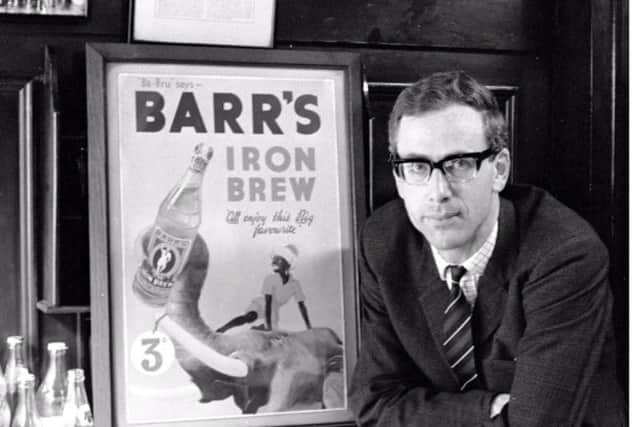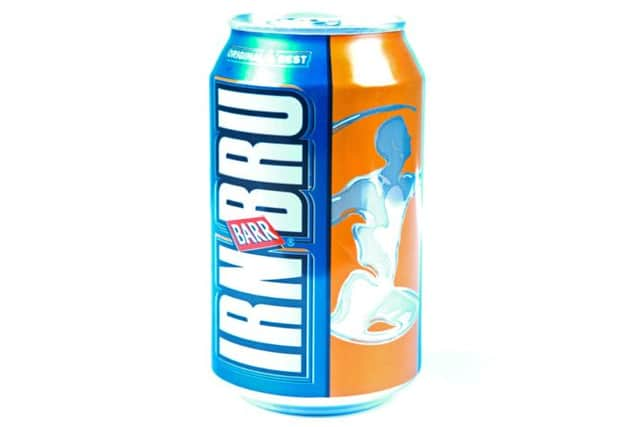Scottish fact of the day: Irn-Bru


The firm was founded in Falkirk by Robert Barr in 1875, but the firm’s origins can be traced back to the family’s cork-cutting business, established in the town in 1830.
Robert Barr’s son, Robert Fulton Barr, set up a second soft drinks business in Glasgow, which was in turn taken over by his brother Andrew Greig (A G) Barr in 1892.
Advertisement
Hide AdIt was Andrew who first sold the drink, initially named Strachan’s Brew before changing the name to Iron Brew.


Andrew died at the age of 31 in December 1903, after contracting Glanders Virus. His younger brother William Snodgrass Barr, then 24-years-old, took over the running of the firm.
William was the grandfather of recently retired Chairman Robin Barr.
Re-brand
The Irn-Bru name came about in July 1946, when a change in laws dictated a re-branding, as the drink is not physically brewed. However, it is believed the re-branding came into effect the following year.
The drink had been removed from sale during the later years of World War II. The Government shut down a number of drinks manufacturers, and limited those remaining to a handful of ‘standard’ drinks recipes such as lemonade.
Iron Brew was removed from sale as it was not a designated standard drink.
Advertisement
Hide AdThe chairman of the firm at the time suggested the idea of altering the spelling of both parts of the name, giving rise to the recognisable Irn-Bru branding known the world over.
Irn-Bru is around level with Coca-Cola in terms of sales in Scotland, and the third best selling soft drink in the UK after Coca-Cola and Pepsi, and consistently outsells global brands such as Fanta, Dr Pepper, Sprite and 7-Up.
Advertisement
Hide AdA planned merger between A.G. Barr and PepsiCo franchisee Britvic in November 2012 fell through when terms could not be agreed.
Marketing strategy
In the early days of Irn-Bru, a long-running advertising campaign was undertaken in the form of ‘The Adventures of Ba-Bru and Sandy’ comic, lasting from the 1930s to the early 1970s.
Along with the comic, a neon sign featuring Ba-Bru stood outside Glasgow Central Station for many years, eventually being removed in the late Seventies.
Ba-Bru was supposedly inspired by the character of Sabu, in Rudyard Kipling’s ‘
A tagline, ‘Made in Scotland from girders’ was used for several years from the 1980s, mainly as a result of the drink’s claim as the most popular soft drink in the country.
The ‘girders’ is often thought to be a reference to the ‘rust’ colour of the drink, as well as the 0.002 per cent ammonium ferric citrate listed among the ingredients - a food additive containing iron hydroxide.
Advertisement
Hide AdIrn-Bru also established Europe’s first ‘fully-looping’ rollercoaster on Blackpool Pleasure Beach. Titled the Irn-Bru Revolution, it measured 675ft long, and had a 45ft drop. It could reach speeds of up to 45mph.
Controversial adverts
From around the year 2000, the firm embarked on a series of memorable adverts, some of which courted controversy for their saucy content.
Advertisement
Hide AdOne advert featured a cow, with the quote: “When I’m a burger, I want to be washed down with Irn-Bru” and drew over 700 complaints, while another showed a woman in a bikini proclaiming: “I never knew four-and-a-half inches could give so much pleasure.”
A billboard advert featuring a depressed goth with the slogan ‘Cheer up Goth. Have an Irn-Bru’ was criticised for inciting bullying.
Among the more family-friendly adverts was a parody of Raymond Briggs’ ‘The Snowman’, which led to a boost for the drink in American markets.
In response to Coca-Cola’s ‘Share a Coke’ campaign, thousands of limited edition bottles of Irn-Bru were produced, carrying the names ‘Senga’, ‘Tam,’ ‘Rab’ and ‘Fanny’ on them - the latter tying in with one of their TV adverts.
Other editions
Over the years, a number of limited edition versions have been produced, including energy drink Irn-Bru 32; sports drink Irn-Bru XS and Fiery Irn-Bru, which had the same taste but left a tingling feeling in the mouth after drinking.
Recipe
Only three people in the whole world reportedly know the recipe to make Irn-Bru: Former company chairman Robin Barr; his daughter Julie Barr (the firm’s Company Secretary and Legal Affairs Manager) and one other A.G. Barr board director whose identity remains confidential.
Advertisement
Hide AdRobin Barr said in a 2007 interview, when just one other person besides himself knew the recipe, that they never travelled in the same aeroplane - just in case.
Production
Irn-Bru’s canning line in Cumbernauld , North Lanarkshire, is capable of producing 690 million cans a year, while the company’s warehouse covers an area of land equivalent to five football pitches.
Advertisement
Hide AdThe 750ml glass bottles that the drink also comes in can be returned to the manufacturer in exchange for the 30 pence deposit paid - a scheme that is widely available in shops across Scotland. It was established in 1905, with each returned bottle worth one halfpenny.
Irn-Bru is also manufactured in five factories in Russia alone, and is manufactured under licence in Canada, the USA and Norway in 2008.
The drink, along with some other Barr products, is exported to Spain, the Netherlands, Germany, Gibraltar, Iceland, Belgium, Poland, Malta, Greece, Cyprus and parts of Africa and Asia.
Coca-Cola produces a drink in South Africa named ‘Iron Brew’ that bears little resemblance to the Barr’s drink in flavour, packaging or colour.
Popular culture
Glasgow rock band The Fratellis featured a t-shirt in the style of the Irn-Bru logo during their 2008 tour, while Elvis Costello references Irn-Bru in his song ‘The St Stephen’s Day Murders’, with the lyrics: ‘There’ll be laughter and tears over Tia Marias, mixed up with that drink made from girders.’
In the National Museum of Scotland’s range of exhibits selected by celebrities, Sir Sean Connery picked a crate of Irn-Bru.